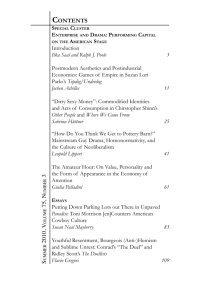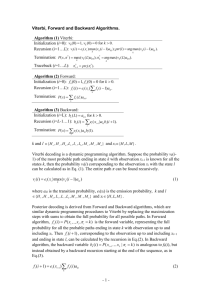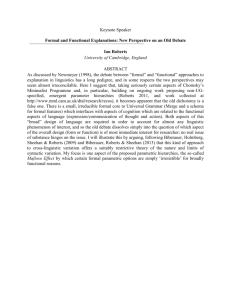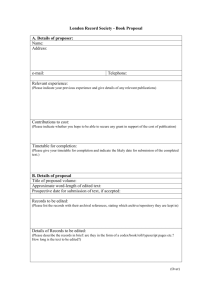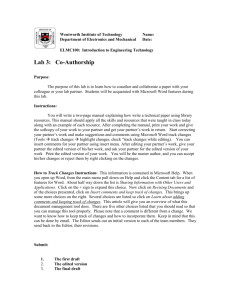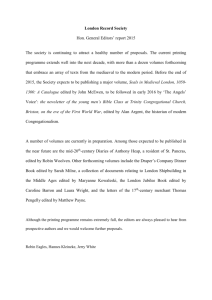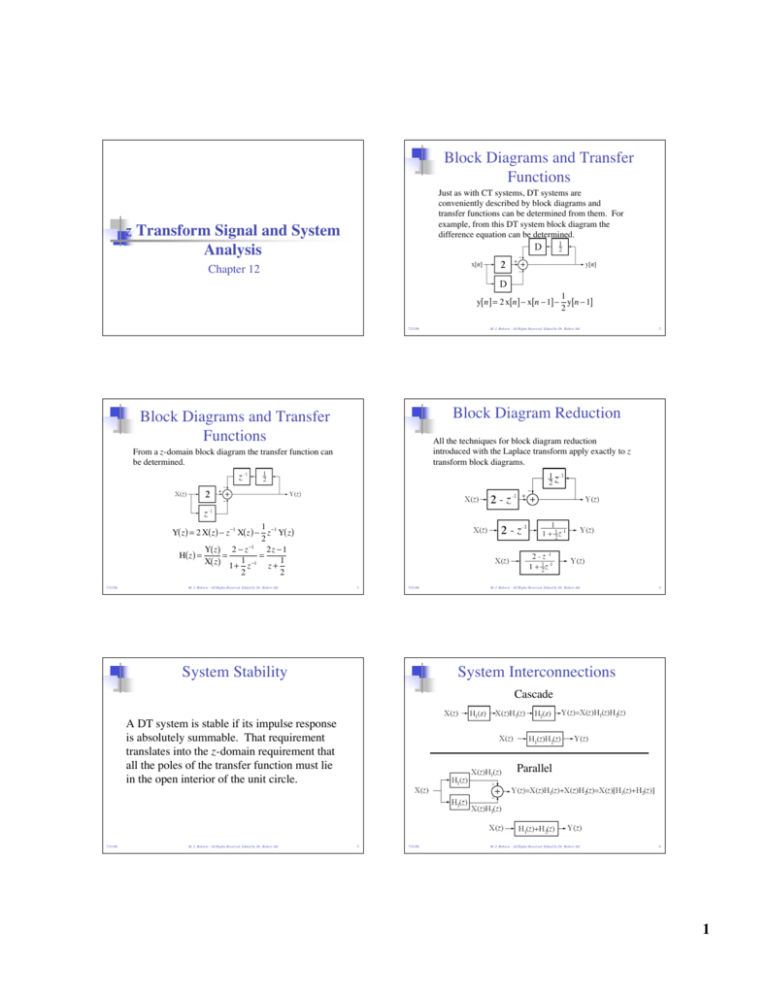
Block Diagrams and Transfer
Functions
Just as with CT systems, DT systems are
conveniently described by block diagrams and
transfer functions can be determined from them. For
example, from this DT system block diagram the
difference equation can be determined.
z Transform Signal and System
Analysis
Chapter 12
1
y[ n ] = 2 x[n ] ! x[n ! 1] ! y[n ! 1]
2
7/21/06
M. J. Roberts - All Rights Reserved. Edited by Dr. Robert Akl
2
Block Diagram Reduction
Block Diagrams and Transfer
Functions
All the techniques for block diagram reduction
introduced with the Laplace transform apply exactly to z
transform block diagrams.
From a z-domain block diagram the transfer function can
be determined.
1
Y( z) = 2 X( z) ! z !1 X( z ) ! z !1 Y( z)
2
Y( z) 2 ! z !1 2z ! 1
H( z ) =
=
=
X( z) 1+ 1 z !1 z + 1
2
2
7/21/06
M. J. Roberts - All Rights Reserved. Edited by Dr. Robert Akl
3
7/21/06
System Stability
M. J. Roberts - All Rights Reserved. Edited by Dr. Robert Akl
4
System Interconnections
Cascade
A DT system is stable if its impulse response
is absolutely summable. That requirement
translates into the z-domain requirement that
all the poles of the transfer function must lie
in the open interior of the unit circle.
7/21/06
M. J. Roberts - All Rights Reserved. Edited by Dr. Robert Akl
Parallel
5
7/21/06
M. J. Roberts - All Rights Reserved. Edited by Dr. Robert Akl
6
1
System Interconnections
Responses to Standard Signals
N( z)
the z
D( z)
z N( z)
transform of the unit-sequence response is Y( z) =
z ! 1 D( z)
If the system transfer function is H( z ) =
H( z ) =
which can be written in partial-fraction form as
N ( z)
z
Y( z) = z 1 + H(1)
D( z )
z !1
N (z )
If the system is stable the transient term, z 1
, dies out
D( z)
z
and the steady-state response is H(1)
.
z !1
Y( z)
H1( z)
H (z )
=
= 1
X( z) 1+ H1( z) H2 ( z) 1 + T( z)
T( z) = H1( z) H 2 ( z)
7/21/06
M. J. Roberts - All Rights Reserved. Edited by Dr. Robert Akl
7
7/21/06
Responses to Standard Signals
Let the system transfer function be H( z ) =
Then Y( z) =
and y[ n ] =
M. J. Roberts - All Rights Reserved. Edited by Dr. Robert Akl
8
Responses to Standard Signals
Unit Sequence Response
One-Pole System
Kz
z! p
z Kz
Kz " z
pz %
=
!
$
'
z ! 1 z ! p 1 ! p # z ! 1 z ! p&
K
(1 ! pn+1 ) u[n]
1! p
Let the constant, K be 1 - p. Then y[ n ] = (1 ! p n+1 ) u[ n ]
7/21/06
M. J. Roberts - All Rights Reserved. Edited by Dr. Robert Akl
9
7/21/06
Responses to Standard Signals
M. J. Roberts - All Rights Reserved. Edited by Dr. Robert Akl
10
Responses to Standard Signals
If the system transfer function is H( z ) =
Unit Sequence Response
Two-Pole System
N( z)
the z transform
D( z)
of the response to a suddenly-applied sinusoid is
N( z) z[ z ! cos( "0 )]
D( z ) z2 ! 2z cos( "0 ) + 1
The system response can be written as
Y( z) =
" N ( z )%
y[ n ] = Z !1 $ z 1 ' + H( p1 ) cos((0 n + ) H( p1 )) u[ n ]
# D( z ) &
and, if the system is stable, the steady-state response is
H( p1 ) cos(!0 n + " H( p1 )) u[n ]
a DT sinusoid with, generally, different magnitude and phase.
7/21/06
M. J. Roberts - All Rights Reserved. Edited by Dr. Robert Akl
11
7/21/06
M. J. Roberts - All Rights Reserved. Edited by Dr. Robert Akl
12
2
Pole-Zero Diagrams and
Frequency Response
Pole-Zero Diagrams and
Frequency Response
For a stable system, the response to a suddenly-applied
sinusoid approaches the response to a true sinusoid (applied
for all time).
Let the transfer function of a DT system be
z
z
H( z ) =
=
z 5 ( z ! p1 )( z ! p2 )
2
z ! +
2 16
p1 =
1+ j2
4
H( e j! ) =
7/21/06
M. J. Roberts - All Rights Reserved. Edited by Dr. Robert Akl
13
p2 =
e j!
e " p1 e j! " p2
j!
7/21/06
Pole-Zero Diagrams and
Frequency Response
1! j2
4
M. J. Roberts - All Rights Reserved. Edited by Dr. Robert Akl
14
The Jury Stability Test
Let a transfer function be in the form, H( z ) =
N( z)
D( z)
where D( z) = a D z D + aD!1 z D!1 +! + a1z + a0
Form the “Jury” array
7/21/06
M. J. Roberts - All Rights Reserved. Edited by Dr. Robert Akl
15
7/21/06
The Jury Stability Test
a0
aD
aD
a0
, b1 =
a0
aD!1
aD
a1
, b2 =
a0
aD!2
aD
a2
, ! , bD!1 =
a0
a1
aD
a D!1
a2 ! a D!2
aD!2 ! a2
aD!1
a1
3
4
5
6
b0
bD!1
c0
cD!2
b1
bD!2
c1
cD!3
b2
bD!3
c2
cD!4
! bD!2
! b1
! cD!2
! c0
bD!1
b0
"
2D ! 3
"
s0
"
s1
"
s2
aD
a0
#
M. J. Roberts - All Rights Reserved. Edited by Dr. Robert Akl
16
CT systems: If the root locus crosses into the
right half-plane the system goes unstable at that
gain.
DT systems: If the root locus goes outside the
unit circle the system goes unstable at that gain.
aD > a0 , b0 > bD!1 , c0 > cD!2 , !, s0 > s2
M. J. Roberts - All Rights Reserved. Edited by Dr. Robert Akl
a1
aD!1
Root locus methods for DT systems are like root
locus methods for CT systems except that the
interpretation of the result is different.
The fourth row is the same set as the third row except in
reverse order. Then the c’s are computed from the b’s in
the same way the b’s are computed from the a’s. This
continues until only three entries appear. Then the system
is stable if
D(1) > 0
(!1)D D( !1) > 0
7/21/06
a0
aD
Root Locus
The third row is computed from the first two by
b0 =
1
2
17
7/21/06
M. J. Roberts - All Rights Reserved. Edited by Dr. Robert Akl
18
3
Simulating DT Systems with DT
Systems
Simulating DT Systems with DT
Systems
The ideal simulation of a CT system by a DT system would have
the DT system’s excitation and response be samples from the CT
system’s excitation and response. But that design goal is never
achieved exactly in real systems at finite sampling rates.
One approach to simulation is to make the impulse response of
the DT system be a sampled version of the impulse response of
the CT system.
h[ n ] = h( nTs )
With this choice, the response of the DT system to a DT unit
impulse consists of samples of the response of the CT system to a
CT unit impulse. This technique is called impulse-invariant
design.
7/21/06
M. J. Roberts - All Rights Reserved. Edited by Dr. Robert Akl
19
7/21/06
Simulating DT Systems with DT
Systems
In impulse-invariant design, even though the impulse response is a
sampled version of the CT system’s impulse response that does not
mean that the response to samples from any arbitrary excitation
will be a sampled version of the CT system’s response to that
excitation.
A CT impulse cannot be sampled. First, as a practical matter
the probably of taking a sample at exactly the time of occurrence
of the impulse is zero. Second, even if the impulse were sampled
at its time of occurrence what would the sample value be? The
functional value of the impulse is not defined at its time of
occurrence because the impulse is not an ordinary function.
M. J. Roberts - All Rights Reserved. Edited by Dr. Robert Akl
All design methods for simulating CT systems with DT systems
are approximations and whether or not the approximation is a good
one depends on the design goals.
21
7/21/06
Sampled-Data Systems
M. J. Roberts - All Rights Reserved. Edited by Dr. Robert Akl
M. J. Roberts - All Rights Reserved. Edited by Dr. Robert Akl
22
Sampled-Data Systems
An ADC simply samples a signal and produces numbers. A
common way of modeling the action of a DAC is to imagine
the DT impulses in the DT signal which drive the DAC are
instead CT impulses of the same strength and that the DAC
has the impulse response of a zero-order hold.
Real simulation of CT systems by DT systems usually
sample
the excitation with an ADC, process the samples and then
produce a CT signal with a DAC.
7/21/06
20
Simulating DT Systems with DT
Systems
When h[ n ] = h( nTs ) the impulse response of the DT system is a
sampled version of the impulse response of the CT system but the
unit DT impulse is not a sampled version of the unit CT impulse.
7/21/06
M. J. Roberts - All Rights Reserved. Edited by Dr. Robert Akl
23
7/21/06
M. J. Roberts - All Rights Reserved. Edited by Dr. Robert Akl
24
4
Sampled-Data Systems
Sampled-Data Systems
Consider the response of the CT system not to the actual signal,
x(t), but rather to an impulse-sampled version of it,
The desired equivalence between a CT and a DT system is
illustrated below.
x! (t ) =
The response is
#
$ x(nT )! (t " nT ) = x(t ) % f
s
s
s
comb( fst )
n="#
y( t ) = h( t ) ! x " (t ) = h(t ) !
$
$
% x[m ]" (t # mT ) = % x[m]h(t # mT )
s
m =#$
s
m=#$
where x[ n ] = x( nTs ) and the response at the nth multiple of Ts
"
is
y( nTs ) = # x[ m] h(( n ! m)Ts )
m=!"
The response of a DT system with h[ n ] = h( nTs ) to the excitation,
x[ n ] = x( nTs ) is
The design goal is to make y d (t ) look as much like y c ( t ) as
possible by choosing h[n] appropriately.
7/21/06
M. J. Roberts - All Rights Reserved. Edited by Dr. Robert Akl
y[ n ] = x[n ] ! h[n ] =
25
7/21/06
Sampled-Data Systems
#
$ x[m ]h[n " m ]
m ="#
M. J. Roberts - All Rights Reserved. Edited by Dr. Robert Akl
26
Sampled-Data Systems
Modify the CT system to reflect the last analysis.
The two responses are equivalent in the sense that the values
at corresponding DT and CT times are the same.
Then multiply the impulse responses of both systems by Ts
7/21/06
M. J. Roberts - All Rights Reserved. Edited by Dr. Robert Akl
27
7/21/06
Sampled-Data Systems
M. J. Roberts - All Rights Reserved. Edited by Dr. Robert Akl
28
Sampled-Data Systems
In the modified CT system,
$
& $
)
y( t ) = x! ( t ) "Ts h( t ) = ( % x( nTs )! ( t # nTs ) + " h(t )Ts = % x( nTs ) h( t # nTs )Ts
' n=#$
*
n=#$
Summarizing, if the impulse response of the DT system is
chosen to be Ts h( nTs ) then, in the limit as the sampling rate
approaches infinity, the response of the DT system is exactly
the same as the response of the CT system.
In the modified DT system,
y[ n ] =
"
"
m=!"
m =!"
# x[m]h[n ! m] = # x[m ]T h((n ! m)T )
s
s
where h[ n ] = Ts h( nTs ) and h(t) still represents the impulse
response of the original CT system. Now let Ts approach zero.
lim y( t ) = lim
Ts !0
Ts !0
#
$ x(nT ) h(t " nT )T
s
n="#
s
s
Of course the sampling rate can never be infinite in practice.
Therefore this design is an approximation which gets better as
the sampling rate is increased.
#
=
& x(% ) h(t " % )d%
"#
This is the response, y c ( t ) , of the original CT system.
7/21/06
M. J. Roberts - All Rights Reserved. Edited by Dr. Robert Akl
29
7/21/06
M. J. Roberts - All Rights Reserved. Edited by Dr. Robert Akl
30
5
Digital Filters
Digital Filters
• Digital filter design is simply DT system
design applied to filtering signals
• A popular method of digital filter design is to
simulate a proven CT filter design
• There many design approaches each of which
yields a better approximation to the ideal as
the sampling rate is increased
• Practical CT filters have infinite-duration
impulse responses, impulse responses which
never actually go to zero and stay there
• Some digital filter designs produce DT filters
with infinite-duration impulse responses and
these are called IIR filters
• Some digital filter designs produce DT filters
with finite-duration impulse responses and
these are called FIR filters
7/21/06
M. J. Roberts - All Rights Reserved. Edited by Dr. Robert Akl
31
7/21/06
Digital Filters
M. J. Roberts - All Rights Reserved. Edited by Dr. Robert Akl
32
Digital Filters
Impulse and Step Invariant Design
• Some digital filter design methods use timedomain approximation techniques
• Some digital filter design methods use
frequency-domain approximation techniques
7/21/06
M. J. Roberts - All Rights Reserved. Edited by Dr. Robert Akl
33
7/21/06
Digital Filters
Impulse and Step Invariant Design
L!1
Step invariant:
1
!
s
H s ( s)
Z
7/21/06
h( t )
Sample
H s ( s)
s
L!1
z
H (z )
z !1 z
!
z "1
z
h[ n ]
h !1 (t )
Z
34
Digital Filters
Impulse and Step Invariant Design
Impulse invariant:
H s ( s)
M. J. Roberts - All Rights Reserved. Edited by Dr. Robert Akl
Impulse invariant approximation of the one-pole system,
1
H s ( s) =
s+a
yields
1
H z ( z) =
1 ! e! aTs z !1
H z ( z)
Sample
h !1 [n ]
H z ( z)
M. J. Roberts - All Rights Reserved. Edited by Dr. Robert Akl
35
7/21/06
M. J. Roberts - All Rights Reserved. Edited by Dr. Robert Akl
36
6
Digital Filters
Digital Filters
Impulse and Step Invariant Design
Impulse and Step Invariant Design
Let a be one and let Ts = 0.1 in H z ( z) =
7/21/06
1
1 ! e! aTs z !1
Step response of H z ( z) =
Digital Filter
Impulse Response
Digital Filter
Step Response
CT Filter
Impulse Response
CT Filter
Step Response
M. J. Roberts - All Rights Reserved. Edited by Dr. Robert Akl
37
7/21/06
38
Digital Filters
A CT step excitation is not an impulse. So what should the
correspondence between the CT and DT excitations be now? If the
step excitation is sampled at the same rate as the impulse response
was sampled, the resulting DT signal is the excitation of the DT
system and the response of the DT system is the sum of the
responses to all those DT impulses.
Why is the impulse response exactly
right while the step response is wrong?
This design method forces an equality
between the impulse strength of a CT
excitation, a unit CT impulse at zero,
and the impulse strength of the
corresponding DT signal, a unit DT
impulse at zero. It also makes the
impulse response of the DT system,
h[n], be samples from the impulse
response of the CT system, h(t).
M. J. Roberts - All Rights Reserved. Edited by Dr. Robert Akl
Notice scale difference
M. J. Roberts - All Rights Reserved. Edited by Dr. Robert Akl
Digital Filters
7/21/06
1
1 ! e! aTs z !1
39
7/21/06
M. J. Roberts - All Rights Reserved. Edited by Dr. Robert Akl
Digital Filters
40
Digital Filters
Impulse and Step Invariant Design
If the excitation of the CT system were a sequence of CT unit
impulses, occurring at the same sampling rate used to form h[n],
then the response of the DT system would be samples of the
response of the
CT system.
Impulse invariant approximation of
H s ( s) =
s
s2 + 400s + 2 ! 10 5
with a 1 kHz sampling rate
yields
H( z ) =
7/21/06
M. J. Roberts - All Rights Reserved. Edited by Dr. Robert Akl
41
7/21/06
z( z ! 0.9135 )
z 2 ! 1.508z + 0.6703
M. J. Roberts - All Rights Reserved. Edited by Dr. Robert Akl
42
7
Digital Filters
Digital Filters
Impulse and Step Invariant Design
Finite Difference Design
Every CT transfer function implies a corresponding differential
equation. For example,
Step invariant approximation of
H s ( s) =
s
H s ( s) = 2
s + 400s + 2 ! 10 5
Derivatives can be approximated by finite differences.
Forward
Backward
d
y n +1 " y n
d
y n " y n "1
( y( t )) ! [ ] [ ]
( y( t )) ! [ ] [ ]
dt
Ts
dt
Ts
with a 1 kHz sampling rate
yields
H z ( z) =
7.97 ! 10 "4 ( z " 1)
z2 " 1.509z + 0.6708
7/21/06
1
d
! ( y(t )) + a y( t ) = x(t )
s + a dt
Central
d
y[n + 1] " y[n " 1]
( y( t )) !
dt
2Ts
M. J. Roberts - All Rights Reserved. Edited by Dr. Robert Akl
43
7/21/06
M. J. Roberts - All Rights Reserved. Edited by Dr. Robert Akl
Digital Filters
Digital Filters
Finite Difference Design
Finite Difference Design
Using a forward difference to approximate the derivative,
H s ( s) =
44
Then
1
y[n + 1] " y[ n ]
!
+ a y[n ] = x[n ]
s+a
Ts
H s ( s) =
1
Ts
" 1 %
! H z ( z) = $
=
s+a
# s + a &' s( z )1 z ) (1) aTs )
Ts
A more systematic method is to realize that every s in a CT
transfer function corresponds to a differentiation in the time
domain which can be approximated by a finite difference.
Forward
z "1
X( z)
Ts
s!
7/21/06
Backward
s!
1" z "1
X( z)
Ts
Central
s!
M. J. Roberts - All Rights Reserved. Edited by Dr. Robert Akl
z " z "1
X( z)
2Ts
45
Finite Difference Design
Direct Substitution and Matched z-Transform Design
Direct substitution and matched filter design use the relationship,
z = esTs to map the poles and zeros of an s-domain transfer
function into corresponding poles and zeros of a z-domain
transfer function. If there is an s-domain pole at a, the z-domain
pole will be at e aTs .
s
s2 + 400s + 2 ! 10 5
Direct Substitution
s ! a " z ! eaTs
6.25 ! 10 "4 z( z " 1)
z 2 " 1.5z + 0.625
Matched z-Transform
s ! a " 1 ! eaTs z !1
7/21/06
46
Digital Filters
with a 1 kHz sampling rate
yields
H( z ) =
M. J. Roberts - All Rights Reserved. Edited by Dr. Robert Akl
Digital Filters
Finite difference approximation of
H s ( s) =
7/21/06
M. J. Roberts - All Rights Reserved. Edited by Dr. Robert Akl
47
7/21/06
z = esTs
M. J. Roberts - All Rights Reserved. Edited by Dr. Robert Akl
48
8
Digital Filters
Digital Filters
Direct Substitution and Matched z-Transform Design
Bilinear Transformation
Matched z-transform approximation of
H s ( s) =
This method is based on trying to match the frequency response
of a digital filter to that of the CT filter. As a practical matter it
is impossible to match exactly because a digital filter has a
periodic frequency response but a good approximation can be
made over a range of frequencies which can include all the
expected signal power.
s
s2 + 400s + 2 ! 10 5
with a 1 kHz sampling rate
yields
H z ( z) =
The basic idea is to use the transformation,
z( z ! 1)
z2 ! 1.509z + 0.6708
s!
1
ln( z )
Ts
or
e sTs ! z
to convert from the s to z domain.
7/21/06
M. J. Roberts - All Rights Reserved. Edited by Dr. Robert Akl
49
7/21/06
Digital Filters
Digital Filters
Bilinear Transformation
Bilinear Transformation
1
The straightforward application of the transformation, s ! ln( z )
Ts
would be the substitution,
Ts
But that yields a z-domain function that is a transcendental
function of z with infinitely many poles. The exponential
function can be expressed as the infinite series,
ex = 1 + x +
This approximation is identical to the finite difference method
using forward differences to approximate derivatives. This
method has a problem. It is possible to transform a stable sdomain function into an unstable z-domain function.
!
x2 x3
xk
+ +!= "
2! 3!
k =0 k!
and then approximated by truncating the series.
M. J. Roberts - All Rights Reserved. Edited by Dr. Robert Akl
51
7/21/06
Digital Filters
Bilinear Transformation
M. J. Roberts - All Rights Reserved. Edited by Dr. Robert Akl
M. J. Roberts - All Rights Reserved. Edited by Dr. Robert Akl
52
Digital Filters
Bilinear Transformation
The stability problem can be solved by a very clever
modification of the idea of truncating the series. Express the
T
s s
exponential as
e 2
e sTs = Ts " z
!s
e 2
Then approximate both numerator and denominator with a
truncated series.
sT
1+ s
2 z "1
2 "z
s!
sT
Ts z + 1
1! s
2
This is called the bilinear transformation because both
numerator and denominator are linear functions of z.
7/21/06
50
Truncating the exponential series at two terms yields the
transformation,
1 + sTs ! z
or
z "1
s!
Ts
H z ( z) = H s ( s) s! 1 ln ( z )
7/21/06
M. J. Roberts - All Rights Reserved. Edited by Dr. Robert Akl
The bilinear transformation
has the quality that every
point in the s plane maps into
a unique point in the z plane,
and vice versa. Also, the left
half of the s plane maps into
the interior of the unit circle
in the z plane so a stable sdomain system is
transformed into a stable zdomain system.
53
7/21/06
M. J. Roberts - All Rights Reserved. Edited by Dr. Robert Akl
54
9
Digital Filters
Digital Filters
Bilinear Transformation
Bilinear Transformation
The bilinear transformation is unique among the digital filter design
methods because of the unique mapping of points between the two
complex planes. There is however a “warping” effect. It can be seen
by mapping real frequencies in the z plane (the unit circle) into
corresponding points in the s plane. Letting z = e j! with Ω real, the
corresponding contour in the s plane is
s=
Bilinear approximation of
H s ( s) =
2 e j! " 1
2
# !%
= j tan
$ 2&
Ts e j! + 1
Ts
or
! = 2 tan"1
7/21/06
with a 1 kHz sampling rate
yields
H( z ) =
$ #Ts &
% 2 '
M. J. Roberts - All Rights Reserved. Edited by Dr. Robert Akl
55
7/21/06
z2 ! 1
z 2 ! 1.52z + 0.68
M. J. Roberts - All Rights Reserved. Edited by Dr. Robert Akl
Digital Filters
Digital Filters
FIR Filters
FIR Filters
FIR digital filters are based on the
idea of approximating an ideal
impulse response. Practical CT
filters have infinite-duration impulse
response. The FIR filter
approximates this impulse by
sampling it and then truncating it to
a finite time (N impulses in the
illustration).
7/21/06
s
s2 + 400s + 2 ! 10 5
M. J. Roberts - All Rights Reserved. Edited by Dr. Robert Akl
56
FIR digital filters can also
approximate non-causal filters
by truncating the impulse
response both before time t = 0
and after some later time which
includes most of the signal
energy of the ideal impulse
response.
57
7/21/06
M. J. Roberts - All Rights Reserved. Edited by Dr. Robert Akl
Digital Filters
Digital Filters
FIR Filters
FIR Filters
The design of an FIR
filter is the essence of
simplicity. It consists of
multiple feedforward
paths, each with a
different delay and
weighting factor and all
of which are summed to
form the response.
58
Since this filter has no feedback paths its transfer function is of the
form,
N !1
H N ( z ) = " a m z !m
m =0
and it is guaranteed stable because it has N - 1 poles, all of which
are located at z = 0.
N "1
h N [ n ] = # am! [ n " m]
m=0
7/21/06
M. J. Roberts - All Rights Reserved. Edited by Dr. Robert Akl
59
7/21/06
M. J. Roberts - All Rights Reserved. Edited by Dr. Robert Akl
60
10
Digital Filters
Digital Filters
FIR Filters
FIR Filters
The effect of truncating an impulse response can be modeled by
multiplying the ideal impulse response by a “window” function. If
a CT filter’s impulse response is truncated between t = 0 and t = T,
the truncated impulse response is
The frequency-domain effect of truncating an impulse response is
to convolve the ideal frequency response with the transform of the
window function.
!h(t ) , 0 < t < T $
h T (t ) = "
% = h( t ) w( t )
, otherwise &
#0
where, in this case,
"t !T %
2'
w(t ) = rect $$
'
$ T '
#
&
7/21/06
M. J. Roberts - All Rights Reserved. Edited by Dr. Robert Akl
HT ( f ) = H( f ) !W ( f )
If the window is a rectangle,
W( f ) = T sinc(Tf )e ! j"fT
61
7/21/06
M. J. Roberts - All Rights Reserved. Edited by Dr. Robert Akl
Digital Filters
Digital Filters
FIR Filters
FIR Filters
62
! f # % j&fT
e
Let the ideal transfer function be H( f ) = rect
" 2B $
The corresponding impulse response is
" " T $$
h( t ) = 2Bsinc& 2B t ! '
# # 2%%
The truncated impulse response is
"t ! T $
" " T $$
2'
h T (t ) = 2Bsinc& 2B t ! ' rect &&
'
# # 2 %%
& T '
#
%
The transfer function for the truncated impulse response is
! f # % j&fT
HT ( f ) = rect
e
'T sinc(Tf )e % j&fT
" 2B $
7/21/06
7/21/06
M. J. Roberts - All Rights Reserved. Edited by Dr. Robert Akl
63
7/21/06
M. J. Roberts - All Rights Reserved. Edited by Dr. Robert Akl
Digital Filters
Digital Filters
FIR Filters
FIR Filters
M. J. Roberts - All Rights Reserved. Edited by Dr. Robert Akl
65
7/21/06
M. J. Roberts - All Rights Reserved. Edited by Dr. Robert Akl
64
66
11
Digital Filters
Digital Filters
FIR Filters
FIR Filters
The effects of windowing a digital filter’s impulse response are
similar to the windowing effects on a CT filter.
"h[n ] , 0 ! n < N %
h N [n] = #
& = h[ n ] w[n ]
, otherwise '
$0
H N ( j! ) = H( j! )
7/21/06
W( j!)
M. J. Roberts - All Rights Reserved. Edited by Dr. Robert Akl
7/21/06
67
7/21/06
M. J. Roberts - All Rights Reserved. Edited by Dr. Robert Akl
Digital Filters
Digital Filters
FIR Filters
FIR Filters
M. J. Roberts - All Rights Reserved. Edited by Dr. Robert Akl
69
7/21/06
M. J. Roberts - All Rights Reserved. Edited by Dr. Robert Akl
Digital Filters
FIR Filters
7/21/06
1.
2.
Bartlett
FIR Filters
(windows continued)
3.
Hamming w[n ] = 0.54 ! 0.46 cos
4.
Blackman
w[n ] = 0.42 ! 0.5 cos
5.
N !1
# 2n
, 0"n"
%N ! 1
2
w[n ] = $
%2 ! 2n , N ! 1 " n < N
&
N !1
2
M. J. Roberts - All Rights Reserved. Edited by Dr. Robert Akl
70
Digital Filters
The “ripple” effect in the frequency domain can be reduced
by windows of different shapes. The shapes are chosen to
have DTFT’s which are more confined to a narrow range of
frequencies. Some commonly used windows are
1'
# 2"n % *
von Hann w[n ] = )1 ! cos
, 0-n<N
$ N ! 1& ,+
2(
68
# 2"n %
, 0'n<N
$ N ! 1&
# 2"n %
# 4 "n %
+ 0.08 cos
, 0'n< N
$ N ! 1&
$ N ! 1&
Kaiser
2
2
#
N " 1% #
N " 1% %
I0 ' ! a #
" n"
$ 2 & $
2 & (&
$
w[n ] =
N " 1%
I0#! a
$
2 &
71
7/21/06
M. J. Roberts - All Rights Reserved. Edited by Dr. Robert Akl
72
12
Digital Filters
Digital Filters
FIR Filters
Windows
7/21/06
FIR Filters
Window Transforms
M. J. Roberts - All Rights Reserved. Edited by Dr. Robert Akl
Windows
73
7/21/06
Window Transforms
M. J. Roberts - All Rights Reserved. Edited by Dr. Robert Akl
74
Standard Realizations
Standard Realizations
• Realization of a DT system closely parallels
the realization of a CT system
• The basic forms, canonical, cascade and
parallel have the same structure
• A CT system can be realized with integrators,
summers and multipliers
• A DT system can be realized with delays,
summers and multipliers
Canonical
Summer
Delay
Multiplier
7/21/06
M. J. Roberts - All Rights Reserved. Edited by Dr. Robert Akl
75
7/21/06
Standard Realizations
M. J. Roberts - All Rights Reserved. Edited by Dr. Robert Akl
76
Standard Realization
Parallel
Cascade
7/21/06
M. J. Roberts - All Rights Reserved. Edited by Dr. Robert Akl
77
7/21/06
M. J. Roberts - All Rights Reserved. Edited by Dr. Robert Akl
78
13

